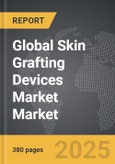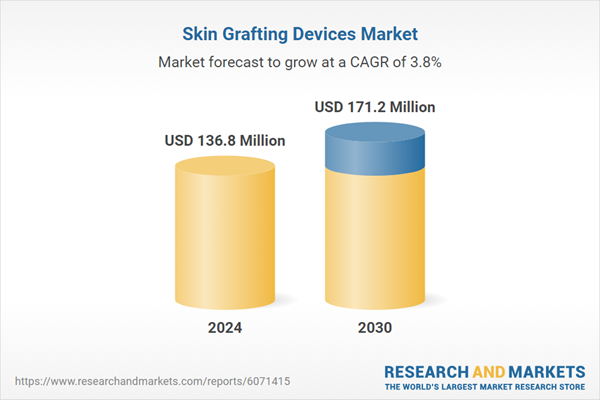Global Skin Grafting Device Market - Key Trends & Drivers Summarized
Why Are Skin Grafting Devices Essential in Burn Treatment and Reconstructive Surgery? Examining Their Expanding Applications
Skin grafting devices are critical tools in reconstructive surgery, particularly in the treatment of burn victims, traumatic injuries, chronic wounds, and reconstructive procedures following tumor removal. These devices facilitate the transplantation of healthy skin from one area of the body to another, promoting wound healing and restoring skin function in patients with severe skin loss. The increasing incidence of burns, diabetic ulcers, and complex surgical wounds has driven the demand for advanced skin grafting solutions, as traditional wound management techniques often fail to achieve complete tissue regeneration. Additionally, skin grafting plays a significant role in cosmetic and aesthetic surgery, including post-mastectomy breast reconstruction and scar revision. With advancements in grafting techniques and regenerative medicine, skin grafting devices are evolving to offer more effective and less invasive solutions for both medical and aesthetic applications.How Are Technological Advancements Improving Skin Grafting Devices? Exploring Innovations in Regenerative Medicine and Graft Engineering
The development of next-generation skin grafting devices has significantly improved surgical outcomes by enhancing graft viability, minimizing donor site morbidity, and accelerating wound healing. Automated skin graft harvesters have simplified the process, allowing for more precise and uniform graft extraction with minimal trauma to the donor site. Additionally, meshed graft expanders and spray-on skin cell therapies have expanded the surface area of grafts, reducing the need for large donor sites while covering extensive wounds more effectively. Advances in bioengineered skin substitutes and 3D bioprinting have introduced synthetic and cultured skin graft alternatives, offering new possibilities for patients who lack sufficient donor skin. Regenerative medicine has also played a crucial role, with stem cell-infused grafts and growth factor-enriched scaffolds enhancing skin regeneration at a cellular level. As these technologies continue to evolve, skin grafting procedures are becoming more efficient, reducing complications and improving long-term functional and aesthetic results.What Challenges Are Affecting the Skin Grafting Device Market? Addressing Cost, Scar Formation, and Donor Site Limitations
Despite significant advancements, the adoption of skin grafting devices faces challenges related to cost, donor site availability, and the risk of graft rejection or scarring. The high cost of advanced skin grafting systems and bioengineered graft materials limits accessibility, particularly in low-income healthcare settings where traditional grafting techniques remain the standard. Additionally, while autografts (patient-derived skin grafts) remain the preferred method due to lower rejection rates, donor site limitations can be a concern, especially in cases of extensive burns. Allografts (donor skin from cadavers) and xenografts (animal-derived grafts) present an alternative, but concerns over immune rejection and ethical considerations limit widespread use. The risk of hypertrophic scarring and contractures after grafting also remains a significant issue, requiring advanced post-surgical care and potential follow-up procedures. Addressing these challenges will require greater investment in cost-effective grafting technologies, improved donor skin expansion techniques, and the continued development of synthetic or lab-grown skin alternatives.What's Driving the Growth of the Skin Grafting Device Market? Identifying Key Expansion Factors and Industry Trends
The growth in the skin grafting device market is driven by several factors, including the rising incidence of burn injuries and chronic wounds, advancements in grafting technologies, and increasing demand for aesthetic and reconstructive procedures. The growing burden of severe burn cases and complex surgical wounds has led to an increased need for effective skin replacement techniques, fueling demand for high-precision grafting devices. The expansion of regenerative medicine and the introduction of bioengineered skin grafts have opened new opportunities for skin grafting in plastic surgery and wound healing. Additionally, the rise of cosmetic and reconstructive procedures, including scar revision and skin resurfacing, has contributed to the market's expansion. As research in biomaterials and tissue engineering progresses, skin grafting solutions are expected to become more advanced, reducing complications and improving patient outcomes. With ongoing innovation and increasing healthcare investments in burn and wound management, the skin grafting device market is set to experience significant growth, providing improved solutions for patients in need of skin restoration.Report Scope
The report analyzes the Skin Grafting Devices market, presented in terms of market value (US$). The analysis covers the key segments and geographic regions outlined below:- Segments: Device Type (Dermatomes, Meshers, Accessories); Application (Burn Care, Chronic Wound Care, Reconstructive Surgery); End-Use (Hospitals, Ambulatory Surgery Centers, Specialty Clinics, Dermatology Clinics).
- Geographic Regions/Countries: World; United States; Canada; Japan; China; Europe (France; Germany; Italy; United Kingdom; Spain; Russia; and Rest of Europe); Asia-Pacific (Australia; India; South Korea; and Rest of Asia-Pacific); Latin America (Argentina; Brazil; Mexico; and Rest of Latin America); Middle East (Iran; Israel; Saudi Arabia; United Arab Emirates; and Rest of Middle East); and Africa.
Some of the 44 companies featured in this Skin Grafting Devices market report include -
- Aesculap Inc. (B. Braun subsidiary)
- AlloSource
- Anika Therapeutics Inc.
- Avita Medical
- AYGUN Surgical Instruments Co. Inc.
- B. Braun Melsungen AG
- Coloplast A/S
- Convatec Inc.
- Desoutter Medical
- Exsurco Medical Inc.
- InGeneron Inc.
- Integra LifeSciences Corporation
- Ishago Surgical
- Kerecis
- Lohmann & Rauscher International
- LUTZ Blades
- Mallinckrodt Pharmaceuticals
- Medaxis LLC
- Medtronic plc
- Merakris Therapeutics, LLC
- MiMedx Group Inc.
- Nouvag AG
- Organogenesis Inc.
- PFM Medical, Inc.
- Rudolf Storz GmbH
- Smith & Nephew plc
- Spiggle & Theis Medizintechnik GmbH
- Stratatech Corporation
- Tissue Regenix Group plc
- Zimmer Biomet
Key Insights:
- Market Growth: Understand the significant growth trajectory of the Dermatomes segment, which is expected to reach US$101.8 Million by 2030 with a CAGR of a 4.2%. The Meshers segment is also set to grow at 3% CAGR over the analysis period.
- Regional Analysis: Gain insights into the U.S. market, valued at $37.3 Million in 2024, and China, forecasted to grow at an impressive 7.1% CAGR to reach $34.7 Million by 2030. Discover growth trends in other key regions, including Japan, Canada, Germany, and the Asia-Pacific.
Why You Should Buy This Report:
- Detailed Market Analysis: Access a thorough analysis of the Global Skin Grafting Devices Market, covering all major geographic regions and market segments.
- Competitive Insights: Get an overview of the competitive landscape, including the market presence of major players across different geographies.
- Future Trends and Drivers: Understand the key trends and drivers shaping the future of the Global Skin Grafting Devices Market.
- Actionable Insights: Benefit from actionable insights that can help you identify new revenue opportunities and make strategic business decisions.
Key Questions Answered:
- How is the Global Skin Grafting Devices Market expected to evolve by 2030?
- What are the main drivers and restraints affecting the market?
- Which market segments will grow the most over the forecast period?
- How will market shares for different regions and segments change by 2030?
- Who are the leading players in the market, and what are their prospects?
Report Features:
- Comprehensive Market Data: Independent analysis of annual sales and market forecasts in US$ Million from 2024 to 2030.
- In-Depth Regional Analysis: Detailed insights into key markets, including the U.S., China, Japan, Canada, Europe, Asia-Pacific, Latin America, Middle East, and Africa.
- Company Profiles: Coverage of players such as Adarsh Surgical Works, Aesculap, Inc., Alma Lasers, Becton, Dickinson and Company, Black & Black Surgical and more.
- Complimentary Updates: Receive free report updates for one year to keep you informed of the latest market developments.
Select Competitors (Total 44 Featured):
- Aesculap Inc. (B. Braun subsidiary)
- AlloSource
- Anika Therapeutics Inc.
- Avita Medical
- AYGUN Surgical Instruments Co. Inc.
- B. Braun Melsungen AG
- Coloplast A/S
- Convatec Inc.
- Desoutter Medical
- Exsurco Medical Inc.
- InGeneron Inc.
- Integra LifeSciences Corporation
- Ishago Surgical
- Kerecis
- Lohmann & Rauscher International
- LUTZ Blades
- Mallinckrodt Pharmaceuticals
- Medaxis LLC
- Medtronic plc
- Merakris Therapeutics, LLC
- MiMedx Group Inc.
- Nouvag AG
- Organogenesis Inc.
- PFM Medical, Inc.
- Rudolf Storz GmbH
- Smith & Nephew plc
- Spiggle & Theis Medizintechnik GmbH
- Stratatech Corporation
- Tissue Regenix Group plc
- Zimmer Biomet
This edition integrates the latest global trade and economic shifts into comprehensive market analysis. Key updates include:
- Tariff and Trade Impact: Insights into global tariff negotiations across 180+ countries, with analysis of supply chain turbulence, sourcing disruptions, and geographic realignment. Special focus on 2025 as a pivotal year for trade tensions, including updated perspectives on the Trump-era tariffs.
- Adjusted Forecasts and Analytics: Revised global and regional market forecasts through 2030, incorporating tariff effects, economic uncertainty, and structural changes in globalization. Includes historical analysis from 2015 to 2023.
- Strategic Market Dynamics: Evaluation of revised market prospects, regional outlooks, and key economic indicators such as population and urbanization trends.
- Innovation & Technology Trends: Latest developments in product and process innovation, emerging technologies, and key industry drivers shaping the competitive landscape.
- Competitive Intelligence: Updated global market share estimates for 2025, competitive positioning of major players (Strong/Active/Niche/Trivial), and refined focus on leading global brands and core players.
- Expert Insight & Commentary: Strategic analysis from economists, trade experts, and domain specialists to contextualize market shifts and identify emerging opportunities.
Table of Contents
Companies Mentioned (Partial List)
A selection of companies mentioned in this report includes, but is not limited to:
- Aesculap Inc. (B. Braun subsidiary)
- AlloSource
- Anika Therapeutics Inc.
- Avita Medical
- AYGUN Surgical Instruments Co. Inc.
- B. Braun Melsungen AG
- Coloplast A/S
- Convatec Inc.
- Desoutter Medical
- Exsurco Medical Inc.
- InGeneron Inc.
- Integra LifeSciences Corporation
- Ishago Surgical
- Kerecis
- Lohmann & Rauscher International
- LUTZ Blades
- Mallinckrodt Pharmaceuticals
- Medaxis LLC
- Medtronic plc
- Merakris Therapeutics, LLC
- MiMedx Group Inc.
- Nouvag AG
- Organogenesis Inc.
- PFM Medical, Inc.
- Rudolf Storz GmbH
- Smith & Nephew plc
- Spiggle & Theis Medizintechnik GmbH
- Stratatech Corporation
- Tissue Regenix Group plc
- Zimmer Biomet
Table Information
| Report Attribute | Details |
|---|---|
| No. of Pages | 380 |
| Published | December 2025 |
| Forecast Period | 2024 - 2030 |
| Estimated Market Value ( USD | $ 136.8 Million |
| Forecasted Market Value ( USD | $ 171.2 Million |
| Compound Annual Growth Rate | 3.8% |
| Regions Covered | Global |









